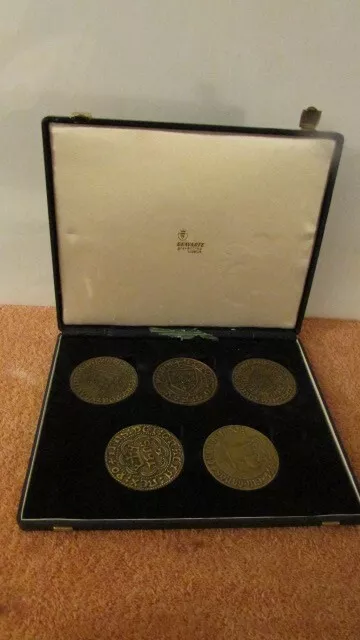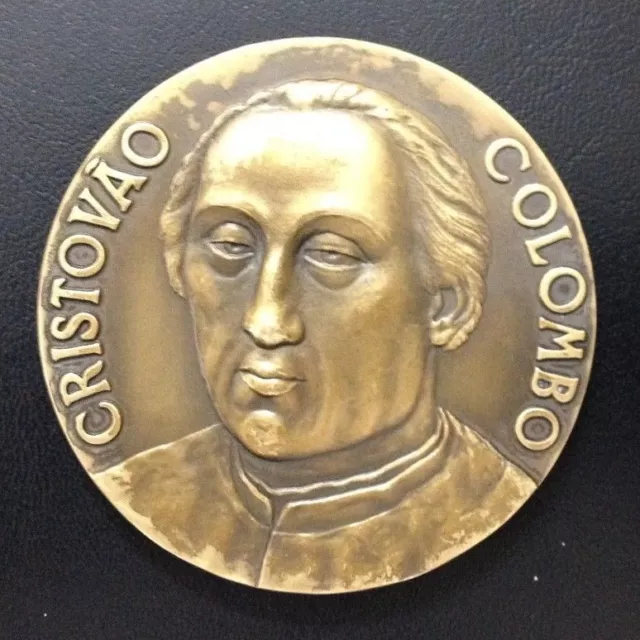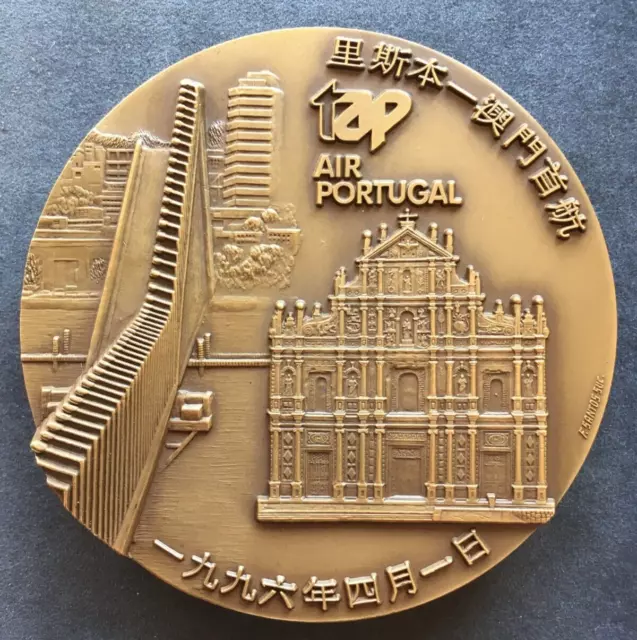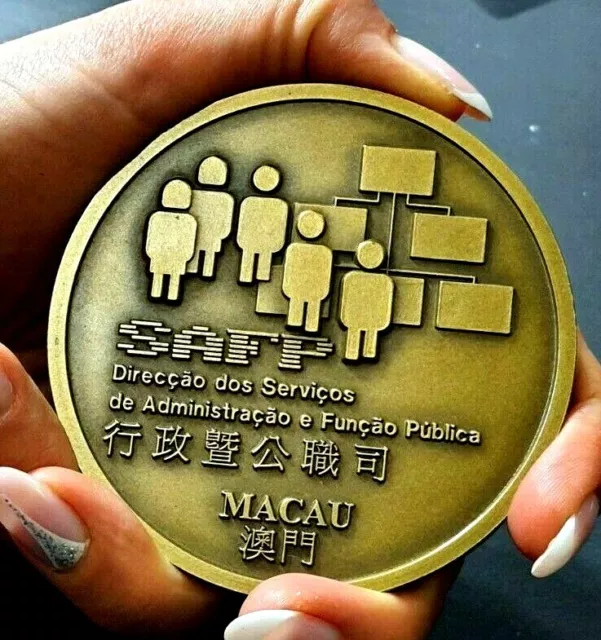Chinese Macau Official boxed bronze BIG medal by Gravarte ,Lisbon 80mm
Shipping from Europe with tracking number
Macau (/m ə ˈ k aʊ / ( listen ) ; 澳門 , Cantonese: [ōu.mǔːn] ; Portuguese: [mɐˈkaw] ), also spelled Macao and officially the Macao Special Administrative Region of the People's Republic of China , is a city and special administrative region of the People's Republic of China in the western Pearl River Delta by the South China Sea . With a population of about 680,000[8] and an area of 32.9 km2 (12.7 sq mi), it is the most densely populated region in the world.
Macau is a former colony of the Portuguese Empire , after Ming China leased the territory as a trading post in 1557. Portugal paid an annual rent and administered the territory under Chinese sovereignty until 1887, when it gained perpetual colonial rights in the Sino-Portuguese Treaty of Peking . The colony remained under Portuguese rule until 1999, when it was transferred to China . Macau is a special administrative region of China , which maintains separate governing and economic systems from those of mainland China under the principle of "one country, two systems ".[9]
Originally a sparsely populated collection of coastal islands,[10] the territory has become a major resort city and a top destination for gambling tourism, with a gambling industry seven times larger than that of Las Vegas .[11] The city has one of the highest per capita incomes in the world, and its GDP per capita by purchasing power parity is one of the highest in the world; however, income inequality remains high.[12] [13] It has a very high Human Development Index , as calculated by the Macau government,[7] and the fourth-highest life expectancy in the world.[14] The territory is highly urbanised and most development is built on reclaimed land ; two-thirds of the total land area is reclaimed from the sea.
During the Qin dynasty (221–206 BC), the region was under the jurisdiction of Panyu County , Nanhai Prefecture of the province of Guangdong .[20] [21] The region is first known to have been settled during the Han dynasty .[22] It was administratively part of Dongguan Prefecture in the Jin dynasty (265–420 AD), and alternated under the control of Nanhai and Dongguan in later dynasties . In 1152, during the Song dynasty (960–1279 AD), it was under the jurisdiction of the new Xiangshan County .[20] In 1277, approximately 50,000 refugees fleeing the Mongol conquest of China settled in the coastal area.[21] [23]
Macau did not develop as a major settlement until the Portuguese arrived in the 16th century. The first European visitor to reach China by sea was the explorer Jorge Álvares , who arrived in 1513.[24] Merchants first established a trading post in Hong Kong waters at Tamão (present-day Tuen Mun ), beginning regular trade with nearby settlements in southern China.[24] Military clashes between the Ming and Portuguese navies followed the expulsion of the Tamão traders in 1521.[25] Despite the trade ban, Portuguese merchants continued to attempt to settle on other parts of the Pearl River estuary, finally settling on Macau.[25] Luso-Chinese trade relations were formally reestablished in 1554 and Portugal soon after acquired a permanent lease for Macau in 1557,[26] agreeing to pay 500 taels of silver as annual land rent.[27]
Macau, early 19th-centuryThe initially small population of Portuguese merchants rapidly became a growing city.[28] The Roman Catholic Diocese of Macau was created in 1576, and by 1583, the Senate had been established to handle municipal affairs for the growing settlement.[28] Macau was at the peak of its prosperity as a major entrepôt during the late 16th century, providing a crucial connection in exporting Chinese silk to Japan during the Nanban trade period.[29] Although the Portuguese were initially prohibited from fortifying Macau or stockpiling weapons, the Fortaleza do Monte was constructed in response to frequent Dutch naval incursions . The Dutch attempted to take the city in the 1622 Battle of Macau , but were repelled successfully by the Portuguese.[30] Macau entered a period of decline in the 1640s following a series of catastrophic events for the burgeoning colony: Portuguese access to trade routes was irreparably severed when Japan halted trade in 1639,[31] Portugal revolted against Spain in 1640,[32] and Malacca fell to the Dutch in 1641.[33] [34]
Maritime trade with China was banned in 1644 following the Qing conquest under the Haijin policies and limited only to Macau on a lesser scale while the new dynasty focused on eliminating surviving Ming loyalists .[35] While the Kangxi Emperor lifted the prohibition in 1684, China again restricted trade under the Canton System in 1757.[36] Foreign ships were required to first stop at Macau before further proceeding to Canton .[37] Qing authorities exercised a much greater role in governing the territory during this period; Chinese residents were subject to Qing courts and new construction had to be approved by the resident mandarin beginning in the 1740s.[38] As the opium trade became more lucrative during the eighteenth century , Macau again became an important stopping point en route to China.[39]
Following the First Opium War and the establishment of Hong Kong , Macau lost its role as a major port.[40] Firecracker and incense production, as well as tea and tobacco processing, were vital industries in the colony during this time.[41] [42] Portugal was able to capitalise on China's post-war weakness and assert its sovereignty; the Governor of Macau began refusing to pay China annual land rent for the colony in the 1840s,[43] and annexed Taipa and Coloane , in 1851 and 1864 respectively.[44] Portugal also occupied nearby Lapa and Montanha ,[43] but these would be returned to China by 1887, when perpetual occupation rights over Macau were formalised in the Sino-Portuguese Treaty of Peking . This agreement also prohibited Portugal from ceding Macau without Chinese approval.[45] Despite occasional conflict between Cantonese authorities and the colonial government, Macau's status remained unchanged through the republican revolutions of both Portugal in 1910 and China in 1911 .[46] The Kuomintang further affirmed Portuguese jurisdiction in Macau when the Treaty of Peking was renegotiated in 1928.[46]
During the Second World War , the Empire of Japan did not occupy the colony and generally respected Portuguese neutrality in Macau. However, after Japanese troops captured a British cargo ship in Macau waters in 1943, Japan installed a group of government "advisors" as an alternative to military occupation. The territory largely avoided military action during the war except in 1945, when the United States ordered air raids on Macau after learning that the colonial government was preparing to sell aviation fuel to Japan. Portugal was later given over US$20 million in compensation for the damage in 1950.[47]
Colonial Macau flag from 1976 to 1999Refugees from mainland China swelled the population as they fled from the Chinese Civil War . Access to a large workforce enabled Macau's economy to grow as the colony expanded its clothing and textiles manufacturing industry, developed its tourism industry, and legalised casino gaming.[48] However, at the height of the Cultural Revolution , residents dissatisfied with the colonial administration rioted in the 1966 12-3 incident , in which 8 people were killed and over 200 were injured. Portugal lost full control over the colony afterwards, and agreed to cooperate with the communist authorities in exchange for continued administration of Macau.[49]
Following the 1974 Carnation Revolution , Portugal formally relinquished Macau as an overseas province and acknowledged it as a "Chinese territory under Portuguese administration".[50] After China first concluded arrangements on Hong Kong's future with the United Kingdom , it entered negotiations with Portugal over Macau in 1986. They were concluded with the signing of the 1987 Joint Declaration on the Question of Macau , in which Portugal agreed to transfer the colony in 1999 and China would guarantee Macau's political and economic systems for 50 years after the transfer.[51] In the waning years of colonial rule, Macau rapidly urbanised and constructed large-scale infrastructure projects, including the Macau International Airport and a new container port .[52] Macau was transferred to China on 20 December 1999, after 442 years of Portuguese rule.[9]
Following the transfer, Macau liberalised its casino industry (which previously operated under a government-licensed monopoly) to allow foreign investors, starting a new period of economic development. The regional economy grew by a double-digit annual growth rate from 2002 to 2014, making Macau one of the richest economies in the world on a per capita basis.[53] Political debates have centred on the region's jurisdictional independence and the central government's adherence of "one country, two systems ". While issues such as national security legislation have been controversial, Macanese residents generally have high levels of trust in the government.[54] [55]
PicClick Insights - Chinese Macau Official boxed bronze BIG medal by Gravarte ,Lisbon 80mm PicClick Exclusive
- Popularity - 0 watchers, 0.0 new watchers per day, 919 days for sale on eBay. 0 sold, 1 available.
- Best Price -
- Seller - 3,467+ items sold. 0% negative feedback. Great seller with very good positive feedback and over 50 ratings.
People Also Loved PicClick Exclusive

Portugal Christmas/Peace medal by Gravarte of Lisbon
$33.26 Buy It Now 21d 23h
Vintage Portuguese Bronze Medals by Gravarte of Lisboa 5 Medal Set
$190.80 Buy It Now 12d 16h
Bronze Medal / 57/1000 / Gravarte Lisboa Portugal "Cristovao Colombo" / M87
$184.72 Buy It Now 3h 10m
Beautiful rare bronze medal of 1st Lisbon/Macao commercial flight, 1 April 1996
$79.88 Buy It Now 22d 20h
Vintage Portuguese Bronze Medals by Gravarte of Lisboa #A
$36.83 Buy It Now 6d 7h
James Cook Bronze Medal Endeavour 1768 Gravarte Lisboa Portugal
$83.19 Buy It Now 18d 14h
Vintage Portuguese Bronze Medals by Gravarte of Lisboa #3
$36.83 Buy It Now 6d 7h
Vintage Portuguese Bronze Medals by Gravarte of Lisboa #D
$36.83 Buy It Now 6d 7h
Vintage Portuguese Bronze Medals by Gravarte of Lisboa #G
$36.83 Buy It Now 6d 7h
Vintage Portuguese Bronze Medals by Gravarte of Lisboa #M
$36.83 Buy It Now 6d 7h
Vintage Portuguese Bronze Medals by Gravarte of Lisboa #X
$36.83 Buy It Now 6d 7h
Vintage Portuguese Bronze Medals by Gravarte of Lisboa #O
$36.83 Buy It Now 6d 7h
Vintage Portuguese Bronze Medals by Gravarte of Lisboa #F
$36.83 Buy It Now 6d 7h
Vintage Portuguese Bronze Medals by Gravarte of Lisboa #J
$36.83 Buy It Now 6d 7h
Vintage Portuguese Bronze Medals by Gravarte of Lisboa #E
$36.83 Buy It Now 6d 7h
Vintage Portuguese Bronze Medals by Gravarte of Lisboa #P
$36.83 Buy It Now 6d 7h
Vintage Portuguese Bronze Medals by Gravarte of Lisboa #V
$36.83 Buy It Now 6d 7h
Vintage Portuguese Bronze Medals by Gravarte of Lisboa #Y
$36.83 Buy It Now 6d 7h
Vintage Portuguese Bronze Medals by Gravarte of Lisboa #L
$36.83 Buy It Now 6d 7h
Vintage Portuguese Bronze Medals by Gravarte of Lisboa #N
$36.83 Buy It Now 6d 7h
Vintage Portuguese Bronze Medals by Gravarte of Lisboa #C
$36.83 Buy It Now 6d 7h
Vintage Portuguese Bronze Medals by Gravarte of Lisboa #Z
$36.83 Buy It Now 6d 7h
Vintage Portuguese Bronze Medals by Gravarte of Lisboa #H
$36.83 Buy It Now 6d 7h
Vintage Portuguese Bronze Medals by Gravarte of Lisboa #W
$36.83 Buy It Now 6d 7h
Vintage Portuguese Bronze Medals by Gravarte of Lisboa #T
$36.83 Buy It Now 6d 7h
Vintage Portuguese Bronze Medals by Gravarte of Lisboa #I
$36.83 Buy It Now 6d 7h
Vintage Portuguese Bronze Medals by Gravarte of Lisboa #K
$36.83 Buy It Now 6d 7h
Vintage Portuguese Bronze Medals by Gravarte of Lisboa #R
$36.83 Buy It Now 6d 7h
Vintage Portuguese Bronze Medals by Gravarte of Lisboa #S
$36.83 Buy It Now 6d 7h
Vintage Portuguese Bronze Medals by Gravarte of Lisboa #Q
$36.83 Buy It Now 6d 7h


